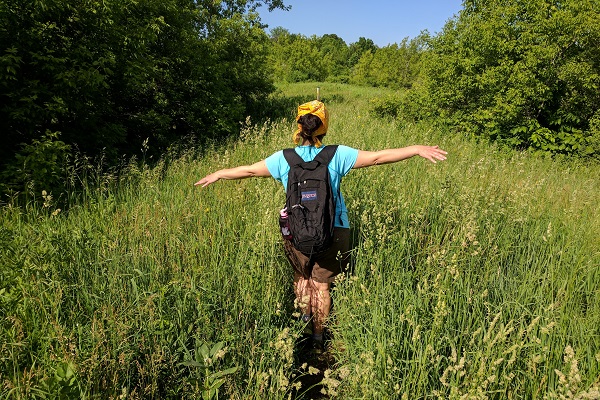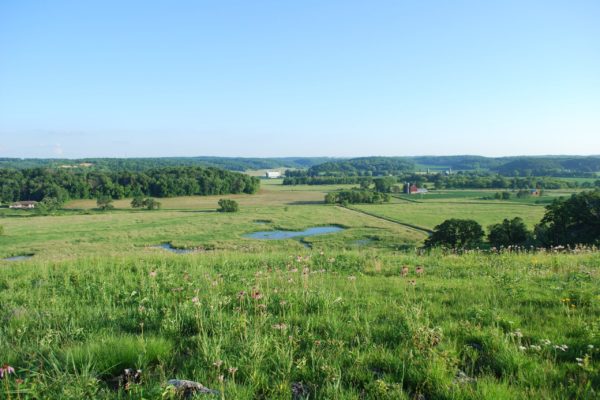
“Thousands of tired, nerve-shaken, over-civilized people are beginning to find out that going to the mountains is going home; that wildness is a necessity.”
~John Muir, environmentalist and author of Our National Parks, 1901
Mountains are hard to come by in Wisconsin. Yet, we have the excellent fortune of the Ice Age National Scenic Trail wending its way through the state. The Ice Age Trail provides us with the necessary wildness and opportunity to come home. A vigorous hike or leisurely walk on a favorite segment of this thousand-mile footpath lets us, the “tired, nerve-shaken, over-civilized,” reacquaint ourselves with a vital source of well-being, nature.

At Home in Nature
It’s been suggested we feel most “at home” in nature because we evolved there. Most of human evolutionary history was spent in environments which lacked these relatively recent developments: four walls, fast cars, internet connection, or the 24/7 news cycle. “Our ancestors most attuned to the cues of nature were the ones who survived to pass along these traits,” points out Florence Williams, author of The Nature Fix. They were the one to hear the lion skulking through the Savannah grasses and leap into action. They also recovered better from the stress of either being chased or leading it. The peaceful or nurturing elements of nature – a sunset, water burbling in a creek, a chorus of birds, or a majestic view – helped them regain their equilibrium.
So, it’s no surprise studies show time spent in natural environments makes us healthier and more creative, empathetic, and social. However, now more than ever, we spend significant amounts of time inside four walls tethered to electronic devices. We’re kept constantly alert to such perils as climate change, a fluctuating stock market, or a pandemic virus. We can only live for so long on a diet of fear, anxiety, and uncertainty before our mental, emotional, and physical health begins to suffer.
We need as much health, creativity, and empathy as we can muster these days, to survive and to thrive, and to be able to think and act beyond ourselves and our fear. The Ice Age Trail is an ideal place for slowing down, gathering our internal resources, and gaining clarity.

Health and Well-Being on the Trail
Brain-Resting: The simplicity of following a winding, yellow-blazed Trail through the woods or across a prairie allows the intellectual, task-focused, decision-making part of our brain to rest. Instead of hard-core problem solving, we enter a state of soft-fascination: we listen to the birds chirping in the trees, admire a grand, old burr oak, or run our hands across soft lichen encasing an erratic. It’s here, in the restorative glacial landscape that our free-ranging, day-dreaming, mind-wandering part of our brain comes forward to play. Empathy, creativity, and insight emerge.
Immune System Boost: Along with a quieter, playful, and rested mind, a leisurely walk in the woods delivers a decrease in cortisol levels, blood pressure, heart rate, anxiety, and increases a positive mood. Japanese scientists discovered trees release beneficial compounds into the forest air – known as phytoncides – containing antibacterial and antifungal qualities which help them fight disease. When people breathe in these chemicals, their concentrations of stress hormones are reduced and the activity of their white-blood cells, known as natural killer (NK) cells, are enhanced, an immune system boost that lasts several weeks. A similar benefit may be found along the tree-lined corridors of the Ice Age Trail.
Happiness and Rejuvenation: A walk on the Ice Age Trail also triggers the release of natural opiates in the brain. These happy hormones, released from our parasympathetic nervous system, soothe and restore us. This flood of restorative chemicals happens as we are immersed, especially during spring, summer, and early fall, in blue and green colors, ones humans have long considered life-giving: healthy habitats full of plants (green), clean water (blue), and the expansive sky overhead (even more blue). Easy-to-process nature scenes – a view across a valley, the Trail winding enticingly ahead, a glittering shimmer of a kettle lake – encourage this release as well. So does the trifecta of soothing nature sounds: wind, water, and birds.
As long as I live, I’ll hear waterfalls and birds and winds sing. I’ll interpret the rocks, learn the language of flood, storm, and the avalanche. I’ll acquaint myself with the glaciers and wild gardens, and get as near the heart of the world as I can.
~John Muir, environmentalist and author
There’s never been better reason to get out for a saunter on the Ice Age Trail. The wildness you crave is available on a nearby Trail segment. Come home to nature. Rest your mind, boost your immune system, and get into a relaxed, happy state. Immerse yourself in the simple act of putting one foot in front of another. Look to the trees, seeking the first yellow blaze and then walk towards the next one. Exhale stress. Inhale well-being.


Pingback: Forest Bathing – Author Amy Laundrie